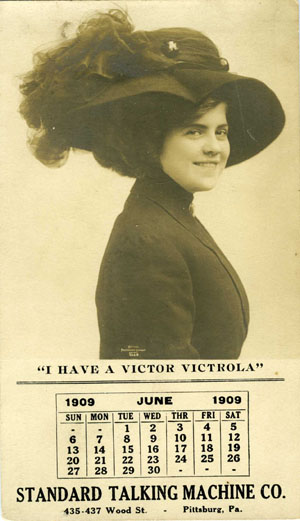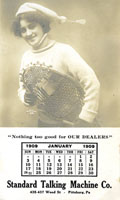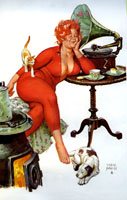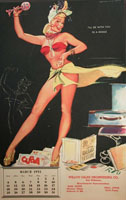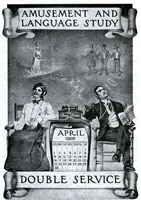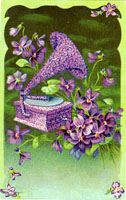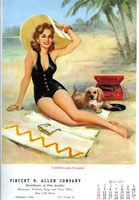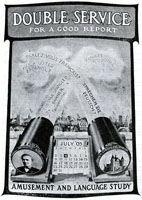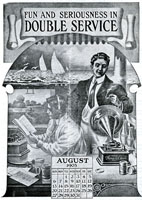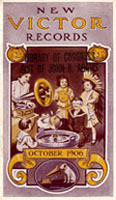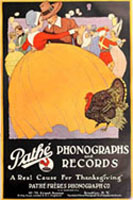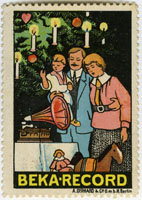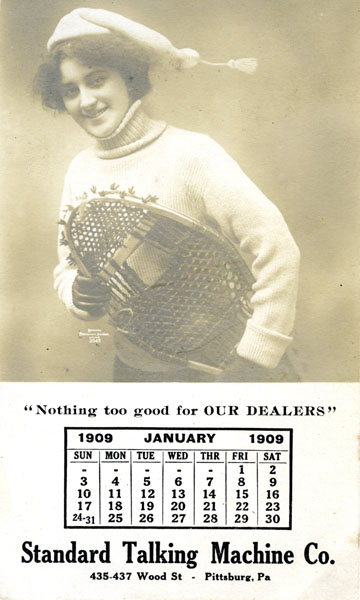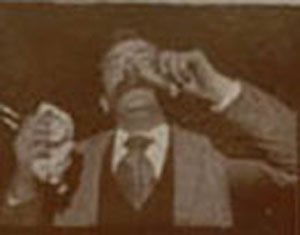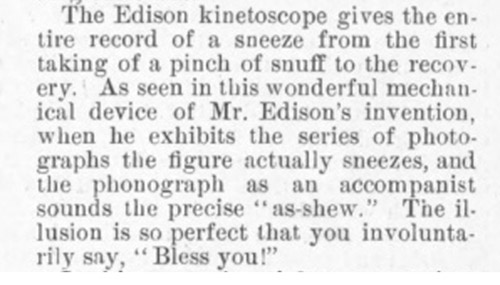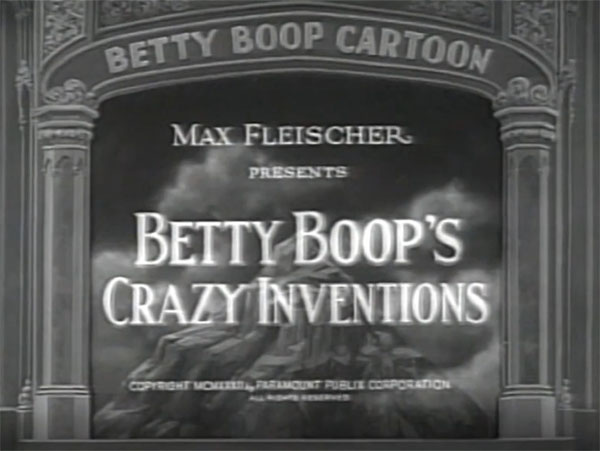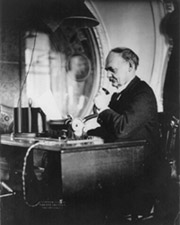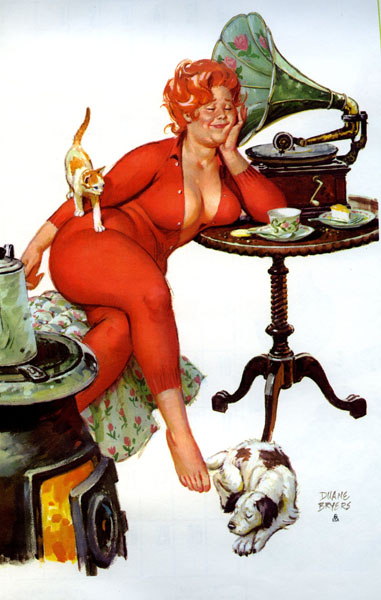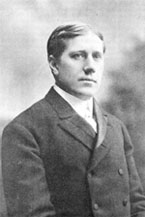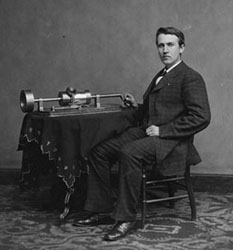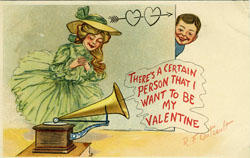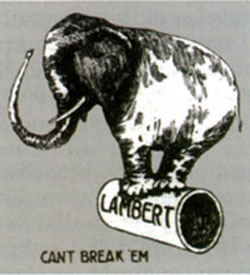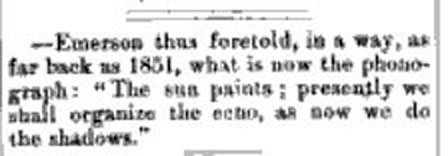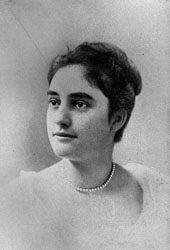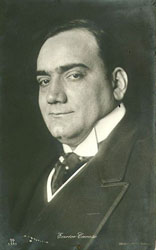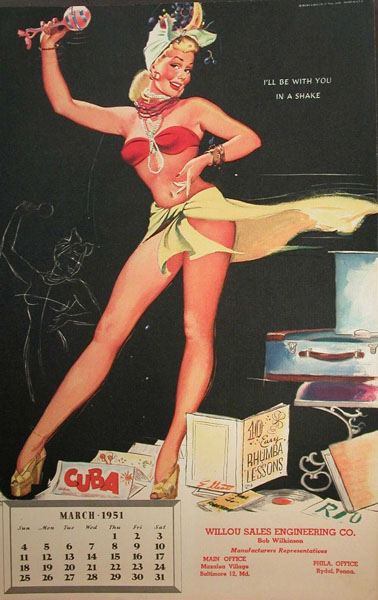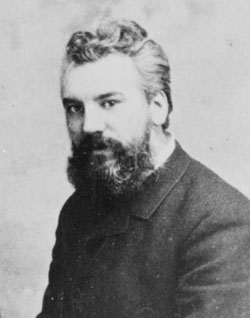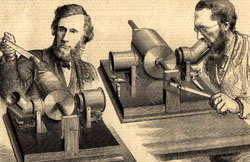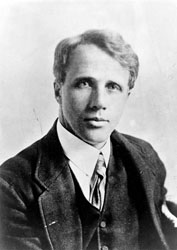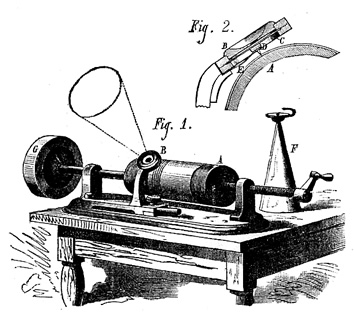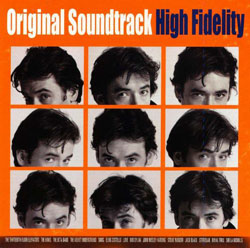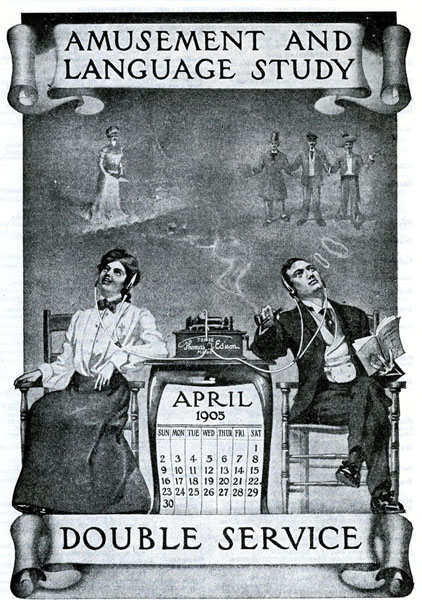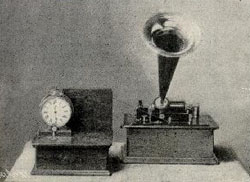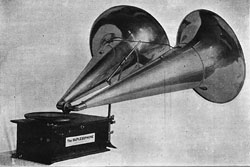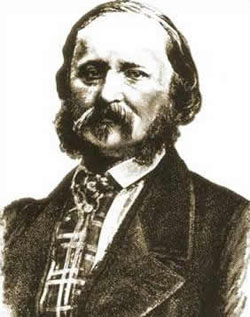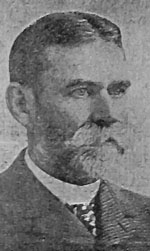May 1 - 1878 Universal Exposition, with Edison
exhibit, opens in Paris.
May 1 - 1878 "The Future of the Phonograph,"
Chicago Tribune, May 1, 1878.
May 1 - 1893 "The Columbia Phonograph Company
in Washington, D.C., had aspirations beyond being a sales agent for the
struggling North American Phonograph Company. On May 1, 1893, Columbia assumed
the management of the American Graphophone Company." (Courtesy of The
Talking Machine, Fabrizio & Paul)
May 2 - 1889 The first mention of a cylinder
of a popular song of the day recorded by a professional artist (all earlier
cylinders on the demonstrations had been of coronet solos, amateur recitations
and the like). The song was "Two Lovely Black Eyes", sung in several languages
by Charles Coborn (1852-1945), and was played at public phonograph lectures
from this date. - Contemporary newspaper account in Great Britain referenced
by George Frow, A Guide to the Edison Cylinder Phonograph (1970).
May 4 - 1878 "Thomas A. Edison. A Tribune Correspondent
Visits Him at Menlo Park--Some of His Recent Extraordinary Discoveries and
Inventions," Chicago Tribune.
May 4 - 1886 Bell and Tainter USA Patent No.
341214 for new device using cardboard cylinders covered with wax (the graphophone).
This patent was noted by Fabrizio and Paul as the patent that yielded "the
greatest impact on the history o f recorded sound ("Recording and Reproducing
Speech and Other Sounds"). It is likely that the Volta experimenters did
not foresee what powerful weapons their patents would become. They could
never have envisioned the "talking machine wars" of fiteen years later.
In fact, they attempted to share their work with Edison, approaching the
Speaking Phonograph Company in 1885 about obtaining a license to make improved
Phonographs. When Edison balked, they formed the Volta Graphone Company,
on January 6, 1886, to be based in Washington, D.C." (Courtesy of The
Talking Machine, Fabrizio & Paul, p. 16)
May 5 - 1888 Patent granted to Edison for solid
wax cylinder and the tapering bore (Courtesy of Edison Cylinder Records,
1889-1912, Koenigsberg, Allen, APM Press, ©1987, p. xv.)
May 5 - 1878 Phonograph message to to Dom Pedro,
Emperor of Brazil". A Tribune Correspondent Visits Him at Menlo Park--Some
of His Recent Extraordinary Discoveries and Inventions," Chicago Tribune.
May 8 - 1900 British Patent 8486 - Method of
and Apparatus for Duplicating Phonograph Records (T.A. Edison) -- Duplicating
smaller cylinders from an original of large diameter (Courtesy of The
Edison Cylinder Phonographs 1877-1929, p. 205, Frow & Sefl)
May 8 - 1970 "Let It Be" by the Beatles released.
May 9 - 1889 British Patent 7794 - Improvements
in or Applicable to Phonographs and in the Manufacture and Use of Phonogram-blanks
or Surfaces for receiving the Sound-record (T.A. Edison) - Including reproducers
and recorders, moulding blanks and making flexible cylinders. Although the
patent does not stress portability, it suggest simplification of operation
and cylinders capable of being flattened for posting; this may have been
the basis of the MILITARY Phonograph. (Courtesy of The Edison Cylinder
Phonographs 1877-1929, p. 204, Frow & Sefl)
May 10 - 1878 "How Edison Amuses Himself," Cincinnati
Saturday Night, reprinted Chicago Tribune.
May
11 - 1896 Mari Sandoz, the author of The Christmas of the Phonograph
Records, is born in Sheridan County, Nebraska. This recollection
by Mari contains many references to specific record titles. It was a remarkable
Holiday Season week for the Sandoz family as her father Old Jules had purchased
an Edison Phonograph and a very large number of cylinder records using inheritance
money that probably should have gone to paying the mortgage and buying new
shoes for the children. Neighbors and visitors came to their "weathered
little frame house" in the Sand Hills from Christmas to New Year's
Day to hear the Edison Phonograph play records which they had never heard
before.
.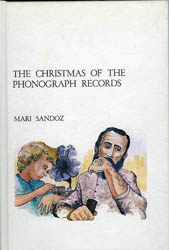
May
12 - 1900 Edison Gem was improved to play two cylinders, instead
of one, on a single winding, and the price was increased to $10.00 (Courtesy
of Edison Cylinder Records, 1889-1912, Koenigsberg, Allen, APM Press,
©1987, p. xxii.)
May 13 - 1888 "Testing the Phonograph," New
York Times, May 13, 1888.
May 13 - 1888 The American Graphophone Company
was organized to act as a manufacturing and distributing arm for the Volta
Graphophone Company. "Principal backs and general agents" were "men such
as James O. Clephane, Andrew Devine, and John H. White who were Supreme
Court or Congressional reporters. These men, because of their field of work,
imagined the potential of the Graphophone for aiding transcription, though
no one yet appreciated the importance of pre-recorded music. (Courtesy of
The Talking Machine, Fabrizio & Paul)
May 15 - 1843 John Kruesi born (May 15, 1843
– February 22, 1899) a Swiss born machinist and a close associate of Thomas
Edison. As Edison's head machinist at Menlo Park he took the rough drawing
from Edison and constructed the first Phonograph. Kruesi was also involved
in many other Edison inventions, including the quadruplex telegraph, the
carbon microphone, the incandescent light bulb and the system of electric
lighting.
May 16 - 1878 "The Wonders of the Phonograph,"
letter to the editor, Chicago Tribune, May 16, 1878. [In response to a skeptical
letter to the editor published the day before.]
May 16 - 1888 Emile Berliner "demonstrated his
Gramophone, or "writer of sound," before the Franklin Institute in Philadelphia,
Pennsylvania, on May 16, 1888." (Courtesy of The Talking Machine,
F&P)
May 17 - 1878 "The
history of recorded sound in Canada can be said to have begun on 17 May
1878 with a demonstration of Edison's recently invented talking machine,
the phonograph, at the Governor-General's residence in Ottawa. The Earl
of Dufferin and his guests spoke Greek and sang popular songs, and listened
as the machine reproduced the sound of their voices. Though the new invention
was greeted with amazement and delight (and the interest of early ethnologists,
who set out to record the speech and music of aboriginal peoples), sound
recording would not become a commercially successful medium of entertainment
until the advent of Emile Berliner and his gramophone." Courtesy National
Library of Canada, The Virtual Gramophone
May
17 - 1894
German patent filed for talking doll. "Doll with Talking Apparatus, a Sound
Path to the Head, and Wide-Mesh Screen Beneath the Wig" was the description
of the patent. "The Kämmer & Reinhardt talking doll was probably first offered
for sale at about this time. It was slightly more than 23" tall, was reportedly
a sensation, but the mechanisms were too fragile and unreliable to ensure
sustained use. Despite its years of development, the doll was a failure
-- one of the most absolute failiures in talking machine history." TOUCH
the picture to see the only known surviving example of the 1894 doll. (Courtesy
of The Talking Machine, Fabrizio & Paul)
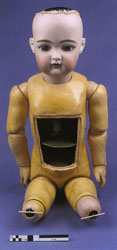
May 18 - 1880 Edison Phonograph Patent
No. 227,679
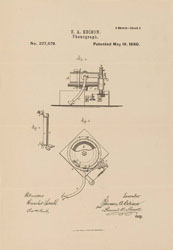
May 18 - 1911 British Patent 3814 - Diaphragms;
Stylus Mountings (T.A. Edison) - the Diamond Model B Reproducer, but still
with the stylus mounted by its shank, as on the Model C. (Courtesy of The
Edison Cylinder Phonographs 1877-1929, p. 206, Frow & Sefl)
May 19 - 1987 Teddy Ruxpin Patent
No. 4,665,640 granted. ABSTRACT: A controller including a servo to time
movement of an animated character with audible sounds reproduced in synchronism
with control signals for the servo.
May
20 - 1851 Emile Berliner birthday (May 20, 1851 – August 3, 1929),
originally Emil Berliner A German-American inventor best known for inventing
the phonograph record (called gramophone record in British English and originally
also in American English) and the phonograph (gramophone in British English
and originally also in American English). He founded the Berliner Gramophone
Company in 1895, The Gramophone Company in London, England, in 1897, Deutsche
Grammophon in Hanover, Germany, in 1898 and Berliner Gram-o-phone Company
of Canada in Montreal in 1899 (chartered in 1904). See Emile
Berliner and the Birth of the Recording Industry.
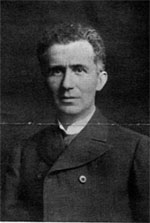
May 25 - 1890 THE PHONOGRAPHIC CALL. Mr. Edison’s
Most Valuable Invention Put to a Practical Use Which Will Make All Lovers
Tremble. By Homer Bassford, from Detroit Free Press, in Boston
Daily Globe.
May 25 - 1877 Birthday of Billy Murray, born
in Philadelphia to Irish immigrant parents. His family moved to Denver and
he would later be known as the Denver Nightingale. Murray was probably the
most popular recording artist of the acoustic era (that is, before microphones
were commonly used in making records). He is also one of the first true
recording stars. See Wikipedia
for additional life and career information.
May 26 - 1896 Gramophone Record
No. 641 "Advertising Plant's Baking Powder" recorded by George Graham
in Washington, D.C. This advertising record is an example of the Phonograph's
early use as an advertising machine.
May 27 - 1890 British Patent 8197 - Improvement
in Means of Apparatus for the Manufacture of Wax-coated Tablets or Cylinders
for use in Graphophones, Phonographs and the like (T.A. Edison) - Coating
a base for a cylinder or a disc evenly with wax material. (Courtesy of The
Edison Cylinder Phonographs 1877-1929, p. 205, Frow & Sefl)
May 27 - 1890 Patent
No. 428,750 issued to Louis Glass and William S. Arnold for Coin Actuated
Attachments for Phonographs (cylinder and discs) which included a repeating
mechanism and controlled sets of listening tubes. As early as November 23,
1889, inventor and businessman Louis Glass rigged an Edison Phonograph with
a repeating mechanism and four selectively controlled sets of listening-tubes
which he installed at the Palais Royal Saloon in San Francisco. The machine
did good business and some fifteen were subsequently fitted out." (Courtesy
of The Talking Machine, p. 24, Fabrizio & Paul)
May 30 - 1878 "The Funny Phonograph. Some New
Facts About the Marvelous Machine. The Wild Dream of a Writer of Fiction
More than Realized. A Hearing and Talking Instrument Combined," St. Louis
Evening Post.
May 31 - 1878 "The
Phonograph and Its Future," Chicago Tribune, May 31, 1878.
May 31 - 1878 Herwick C. Dodge "The Speaking
Phonograph" St. Louis Evening Post
JUNE

June 2 - 1966 "I Want to Tell You", written
by George Harrison and recorded on June 2, 1966 was originally released
by The Beatles on their 1966 album Revolver.
June 5 - 1901 The
Invincible Eagle March (Matrix [Pre-matrix B-]844) was recorded by Sousa's
Band, John Philip Sousa (composer), Arthur Pryor (conductor). Take Place:
(Camden, New Jersey [unconfirmed]) M-1 Master Victor 844 10" Disc (VEDVR)
- Composed for the Pan-American Exposition in 1901. Sousa believed at the
time that this "sunshine march" would some day be as popular as his "Stars
and Stripes Forever". He described it as showing military spirit at its
"lightest and brightest".

June 6 - 1878 "The Phonograph. Edison's Wonderful
Invention to be Exhibited Here," Indianapolis News, June 6, 1878.
June 13 - 1878 "Edison's
Phonograph," Indianapolis News, June 13, 1878.
June
14 - 1878 "Speaking Phonograph" mouthpiece
experiments - Edison and his team at Menlo Park
experiment on mouthpiece of his Speaking Phonograph to try to get the hissing
consonants to reproduce better.
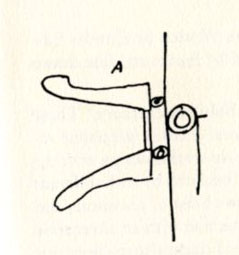
June 15 - 1878 "The
Amusement Record," Indianapolis Saturday Herald, reported a Phonograph exhibition
at twenty-five cents a head at Wright's hall.
June 15 - 1966 The Beatles released their studio album
"Yesterday and Today."
June 16 -
1888, Edison's "Perfected Phonograph" is announced as completed
after 72 straight hours work by Edison and his assistants. This was the
first commercial phonograph.
June 16 - 1856 Birthday of Francis
James Barraud. Born in London Barraud would be the painter of Nipper,
the famous terrier of the Victor Talking Machine Company who listened to
His Masters Voice.
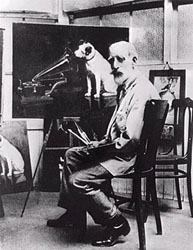
June 18 - 1942 Birthday of Sir James Paul McCartney
CH MBE (born 18 June 1942). "An English singer, songwriter, musician,
composer, and record and film producer who gained worldwide fame as co-lead
vocalist and bassist for the Beatles. His songwriting partnership with John
Lennon remains the most successful in history." - Wikipedia
An honorary Friend
of the Phonograph.

June 19 - 1902 Birthday of Gaetano Alberto "Guy"
Lombardo (born June 19, 1902 in London, Ontario; died November 5, 1977).
Forming The Royal Canadians in 1924 with his brothers Carmen, Lebert, and
Victor and other musicians from his hometown, Lombardo led the group to
international success, billing themselves as creating "The Sweetest Music
This Side of Heaven." Listen to "Get
Out Those Old Records."
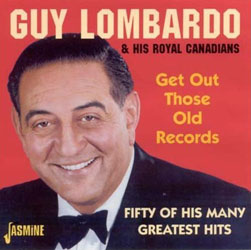
June
21 - 1961 The short film Donald and the Wheel (starring Donald
Duck) was released to theaters. The Gramophone is used to help explain the
importance of the wheel's invention.
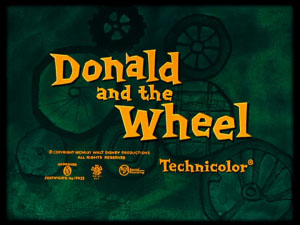
June
21 - 1939 "The Record" by Forrest Ackerman and Ray Bradbury
published in Futuria Fantasia, Summer 1939. This is the story of
how the phonograph record "Sonny Boy" saved mankind in the future.
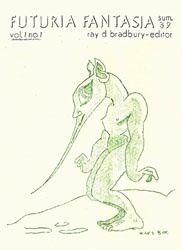
June 22 - 1878 "The Phonograph Wins a Victory,"
Scientific American, June 22, 1878. Read the newspaper's account of the
remarkable reproduction of cornet solos by Mr. Levy.
.June 25 - 1967 All
You Need Is Love", written by John Lennon and credited to Lennon/McCartney,
was first performed by The Beatles on Our World, the first live global
television link. Watched by 400 million in 26 countries, the program was
broadcast via satellite on 25 June 1967.
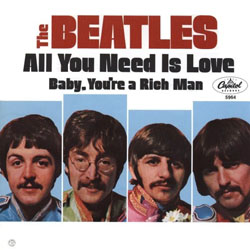
June 28 - 1966 Birthday of John Cusack, an honorary
Friend of the Phonograph for his role in the movie "High
Fidelity" where Cusack plays the owner of a record store and self-processed
audiophile.
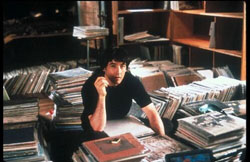
June 28 - 1888 Jessie H. Lippincott purchased
the Edison Phonograph Company from Edison for $500,000. (Courtesy of Edison
Cylinder Records, 1889-1912, Koenigsberg, Allen, APM Press, ©1987,
p. xvi).
JULY
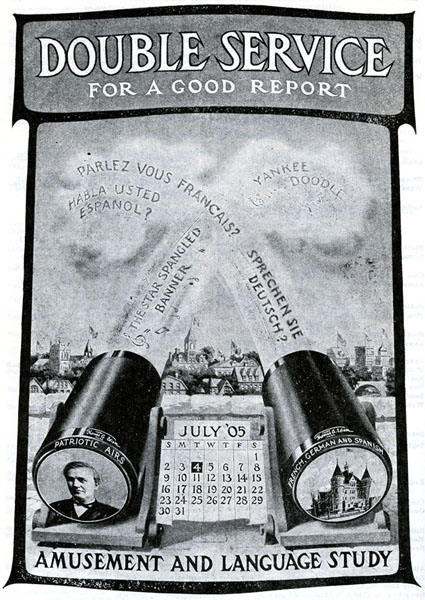
July 4
- From 1776 to the present day, July 4th
has been celebrated as the birth of American independence. Fireworks, parades,
political speeches, and family gatherings each year mark this day in the
United States. The Phonograph, likewise, has celebrated
July 4th with advertisements and images promoting "American patriotic
airs from revolutionary days to date."
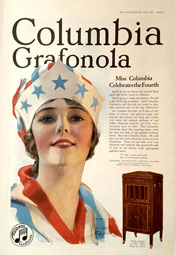
July 5 -1898 British Patent 14803 - Improvements
in Apparatus for Reproducing Sound Records (Gianni Bettini) - Duplication
of cylinder records. (Courtesy of The Edison Cylinder Phonographs 1877-1929,
Frow & Sefl)
July 7 -1940 Birthday of Richard Starkey, Jr.,
better known by his stage name Ringo Starr. English musician, singer-songwriter,
and actor who gained worldwide fame as the drummer for the rock group The
Beatles and now an honorary member of Friends of the Phonograph sitting
next to an Edison GEM.

July 10 - 1900 U.S. Patent Office issued TRADE
MARK FOR GRAMOPHONES (No. 34890) to Emile Berliner.
July 10 - 1964 A Hard Day's Night is the
third studio album by The Beatles, released on 10 July 1964 as the soundtrack
to their film A Hard Day's Night. A Hard Day's Night became
their first album to consist solely of original material, and was The Beatles
only release to consist solely of songs written by Lennon-McCartney. (Courtesy
of the Beatles Bible)

July 11 - 1946 The birthday of Sue Lyon's, born
in in Davenport, Iowa and an honorary Friend of the Phonograph for
her scene in the 1964 movie The Night of the Iguana where she asks
for "More music!" to be played from a Gramophone.
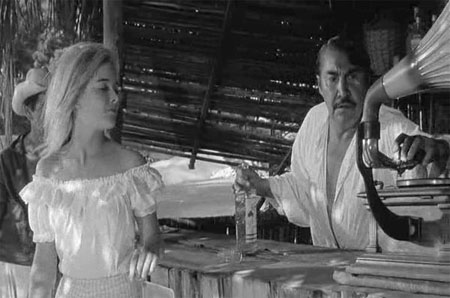
July 14 - 1888 North American Phonograph Company
born. (Courtesy of Edison Cylinder Records, 1889-1912, Koenigsberg,
Allen, APM Press, ©1987, p. xvi.)
July 18 - 1877 Phonograph principle realized
by Edison in his diary by referring to the storing and repetition of sound
of the human voice. (ECP, Frow & Sefl). This is the date Fabrizio and Paul
note that "Edison began to evolve the concept of a talking machine in his
laboratory at Menlo Park, New Jersey." (Courtesy of The Talking Machine,
Fabrizio & Paul).
July 21 - 1891 Columbia Phonograph Company begins
offering phonographs for sale. (Courtesy of Edison Cylinder Records,
1889-1912, Koenigsberg, Allen, APM Press, ©1987, p. xvi).
July 21 - 1891 Edison
received patent for improvement in phonograph (Case no, 867 related to phonograph
doll) with the following specifications: "The invention relates mainly to
reproducing phonographs designed to be inclosed in dolls or other toys,
and bearing a short sound-record intended to be reproduced as often as required.
July 22 - 1910 The 'dog' picture together with
the words "His Master's Voice" was registered as a Trade Mark.
July 24 - 1894 "George Tewksbury, who would later
write a handbook about the Edison Phonograph, adapted some of them with
his coin-op device (patent No. 523,556, July 24, 1894). Working as an officer
of the local branch of the North American Phonograph Company for the Kansas
territory, he claimed to have operated his machiine as early as 1890, though
they were actually put on sale a few years later by the United States Phonograph
Company of Newark, New Jersey." (Courtesy of The Talking Machine,
Fabrizio & Paul)
July
24 - 2022 - Celebration of Life Day for Ron Jester, a Friend
of the Phonograph
July
26 - 1848 Birthday of Henri Lioret, born in Moret-sur-Loing,
France. In 1893 Henri created the first French phonograph and the talking
doll, the Bebe Phonographe, using an Emile Jumeau porcelain doll. To learn
more about Lioret cylinder records go to UCSB
Cylinder Audio Archive.
.
July 30 - 1878 British Patent 2909 + 3 Disclaimers)
- Controlling by Sound the Transmission of Electric Currents and Reproduction
of Corresponding Sounds at a Distance (T.A. Edison) - the first phonograph
outline. (Courtesy of The Edison Cylinder Phonographs 1877-1929,
Frow & Sefl)
.July 30 - 1890 "It
Does Not Injure the Ear. A Senseless Objection Raised Against the Phonograph,"
New York Times, July 30, 1890." Read this article about the Philadelphia
Board of Park Commissioners crusade against the phonograph.
July 31 - 1900 British Patent 13693 (Amendment)
- Process of and Apparatus for Duplicating Phonographic Records (T.A. Edison)
- The 'Gold Moulded' Method. (Courtesy of The Edison Cylinder Phonographs
1877-1929, Frow & Sefl)
July 31 - 1917 The Victor Talking Machine Company,
on July 31, filed its answer to the complaint of the Federal Trade Commission
calling upon the company to show cause why an order should not be issued
forbidding it to continue the practice of selling its machines under the
license system pronounced illegal by the Supreme Court...In its reply the
company states it has voluntarily ceased to do the acts set forth in the
complaint...and is no longer disposing of its machines with the proviso
they should be used only as set forth by the company. Neverthless, Edison
and Victor continued business as usual and ended up signing consent decrees
in 1918 and paying assessments. "To quote the Government from Victor's decree,
May 3, 1918, "For many years the defendant had systematically made contracts
and engaged in a conspiracy in restraint of that trade." (Courtesy of The
Talking Machine, Fabrizio & Paul)
AUGUST
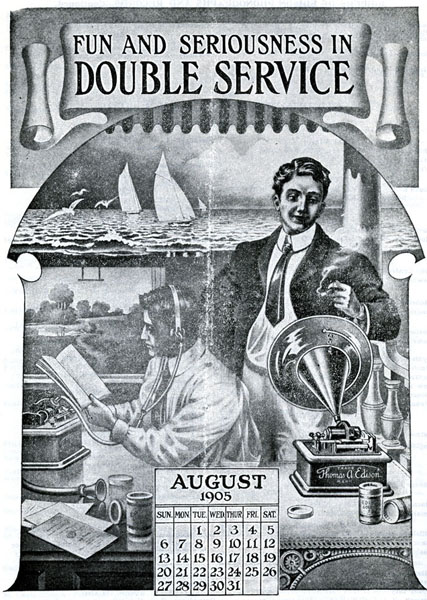
August 1 - 1897 "Columbia purchased the Chicago
Talking Machine Company on August 1, 1897. This pioneer talking machine
agency...had been involved in selling Amet spring motors as well as the
mysterious three-spring, aluminum "Chicago Motor" which had run afoul of
the triple-spring Capps motor of the United States Phonograph Company. In
an ironic development, Columbia intorduced its first three-spring motoor
one month after buying the Chicago Talking machine Company. Although Columbia's
new motor was built of more prosaic steel and brass, the similarity to the
old "Chicago Motor" was unmistakable." (Courtesy of The Talking Machine,
Fabrizio & Paul)

August 1 - 1901 George Burt of the George Burt
Company of Milburn, New Jersey, "established a subsidiary on August 1, 1901:
the Globe Record Company. Within a short time, Globe was producing a satisfactory
disc record known as the "Climax."
(Courtesy of The Talking Machine, Fabrizio & Paul)
August 14 - 1897 Eldridge Johnson applied "for
a patent (No 601,198) on an improved motor and brake for the Gramophone.
These features were used in the machine marketed as the Berliner "Improved
Gramophone," which sold for $25.00. The "Improved Gramophone" single-handedly
enabled the disc record to become a serious competitor of the cylinder.
This model would later become part of the world's most famous and best-loved
trademark." (Courtesy of The Talking Machine, Fabrizio & Paul)
August
17
- 1877 Spkg Telegh. - Technical Note from Edison Lab Notebook - "In
my apparatus for recording & reproducing the human voice -- I propose
using a paper coated with a substance which becomes very soft by heat &
when cold is extremely hard like a sealing wax.
Phonograph. "Another idea Indent the paper in spiral
grooves or on a long strip cover whole of paper with tin foil. The point
on the diaphragm will then easily indent --- (p.502, Technical Notes --1013--
The Papers of Thomas A. Edison, Volume 3
August 20 - Voyager 2 launched by NASA on August
20, 1977. September 5 - Voyager 1 launched by NASA on September 5, 1977.
August 21 - 1894 Edison...as principal creditor
of the penniless North American Phonograph Company, threw it into bankruptcy
on August 21, 1894. Here ended the unhappy alliance of the Edison and Graphophone
forces, and thus began several years of virtual anarchy in the talking machine
business." (Courtesy of The Talking Machine, Fabrizio & Paul)
August
23 - 1977 Gold plating of the Voyager records took place on August
23, 1977; afterward, the records were mounted in aluminum containers and
delivered to JPL.
The record is constructed of gold-plated copper and is 12 inches (30 cm)
in diameter. The records also had the inscription "To the makers of music
– all worlds, all times" hand-etched on its surface. (Courtesy of Jet Propulsion
Laboratory, California Institute of Technology)
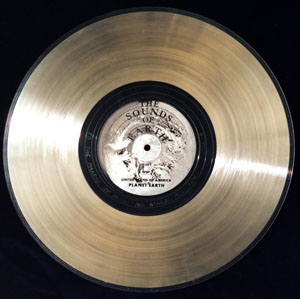
August 29 - 1958 "Move
It" by Cliff Richard and the Drifters (the UK band that would later
become "The Shadows") is released. This single "is credited with being
one of the first authentic rock and roll songs produced outside the United
States." Wikipedia
SEPTEMBER
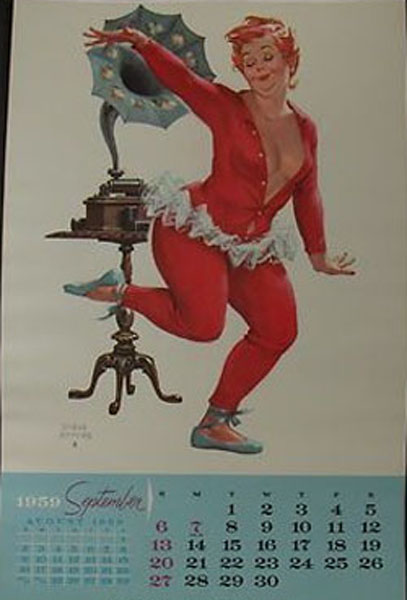
September 1 - 1911 The first "Victrola the Fourth"
was shipped from the Camden factory and was Victor's response ($15.00) to
the low cost, concealed-horn phonograph that had been successfully introduced
by Columbia the previous year.
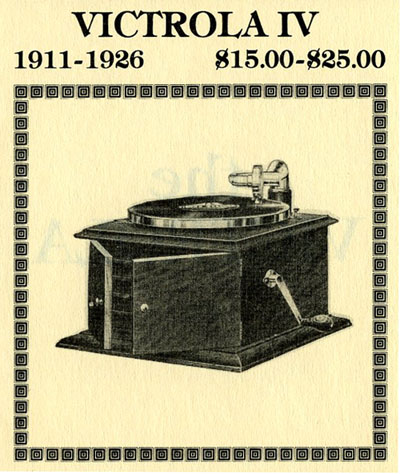
Courtesy of "Look for the Dog,"
Robert W. Baumbach
September 5 - 1977 Voyager 1 launched by NASA
on September 5, 1977.
September 5 - 1967 "I am the Walrus"
recorded by the Beatles.
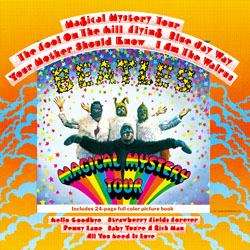
September 7 - 1877 Edison's development of the
Phonograph evolves. "A statement with accompanying sketches
was prepared to announce the invention of the newly dubbed Phonograph,
but not released as improvements continued." (Courtesy of The Talking
Machine, Fabrizio & Paul) Draft Sketch and Notes related to the
Phonograph (Courtesy of The Papers of Thomas A. Edison, Volume 3,
Johns Hopkins University Press)
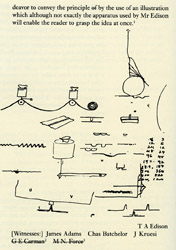
September 9 - 1922 Release of "Carolina
in the Morning" by Paul Whiteman & His Orchestra on Victor
18962-A
September 11 - 1900 British Patent 16146 - Process
of Making Metallic Duplicate Phonograph Records (T.A. Edison) - Making metallic
copy of original cylinder, a metallic matrix and metallic positives. (Courtesy
of The Edison Cylinder Phonographs 1877-1929, Frow & Sefl)
September 12 - 1987 Birthday of Emmy
Rossum, an honorary Friend of the Phonograph for her role in
the movie "Song Catcher" where she recorded many songs on an Edison
Phonograph.
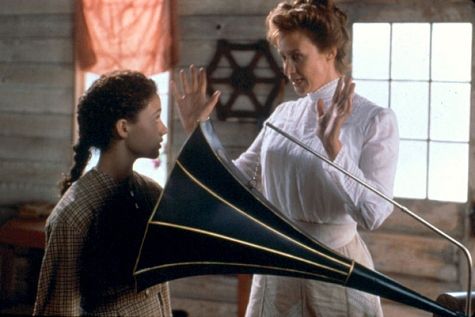
September 15 - 1899 The Gramophone Company offered
Barraud 100 pounds for the painting of Nipper ("His Master's Voice) and
transfer of the copyright, which Barraud accepted.

September 15 - 1890 Phonograph
arcades, with rows of nickel-operated Edison machines for which the records
were frequently changed, blossomed in big cities. The Ohio Phonograph Company
opened one in Cleveland on September 15, 1890..." (Courtesy of The Talking
Machine, Fabrizio & Paul)
September 17 - 1936 Birthday of Earl
Kenneth Forsse in Bellwood, NE and a honorary Friend of the Phonograph
for his invention of Teddy Ruxpin, the creative twentieth century talking
doll, which would be much more successful than Edison's talking doll of
1890.


September 21 - 1877 Edison describes idea of
"recording by embossing or otherwise" documented in Edison Papers Technical
Note 1062 "Telephony and Phonograph." (Courtesy of The Papers of Thomas
A. Edison, Volume 3, Johns Hopkins University Press)

September 23 - 1906 “Suggestions for Decatur
Bicyclists,” Decatur Review (Decatur, Illinois), Sept. 23, 1906.
(Courtesy of of Phonozoic Text Archive).
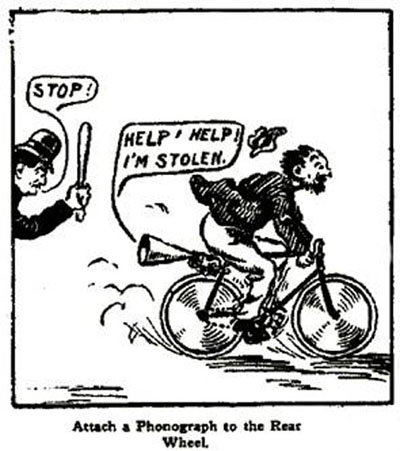
September 28 - 1895 "The Phonograph Explained
Just What Ailed a Big Pump in California," Scientific American, Sept.
28, 1895.
September 30 - 1877 Edison draft letter to [Jay
Gould?] reporting that he has "nearly completed a machine which records
the human voice on paper from which after the lapse of any time the same
voice can be reproduced at any speed & with all its fine inflection." (Courtesy
of The Papers of Thomas A. Edison, Volume 3, Johns Hopkins University
Press)

OCTOBER
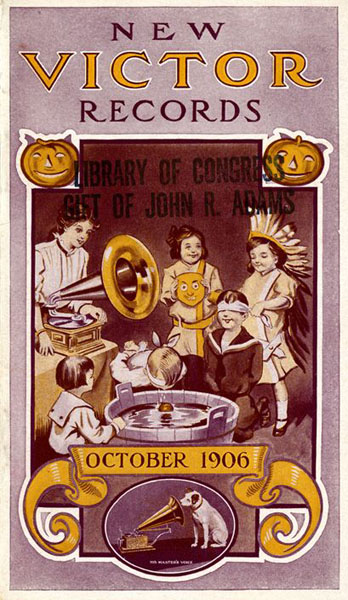
October
1 - 1842 Birthday of Charles Cros (or Émile-Hortensius-Charles
Cros), born in Fabrezan, Aude. French poet and inventor who was the first
person to conceive a method for reproducing recorded sound with an invention
he named the Paleophone.
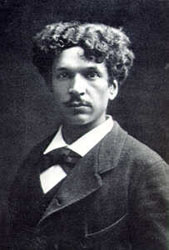
October 3 - 1901 The Victor Talking Machine Company
was incorporated on October 3, 1901, and organized two days later. It was
not a new enterprise, but a merger of the interests of Eldridge R. Johnson
with those of the Consolidated Talking Machine Company of America. (Courtesy
of the David Sarnoff
Library).
October 4 - 1928 For the first time, Edison offered
a radio under the Edison name to the public. "It is ironic that the company
founded by America's pioneeer electrician should have delayed so long. Edison's
first electrically recorded "Diamond Discs" had made their debut a year
earlier, to general consumer apathy. The company's record sales continued
to suffer under Thomas Edison's stubbon allegiance to the vertically recorded
format." (Courtesy of The Talking Machine, Fabrizio & Paul, p.
235)
October 6 - 1977 U.S.
postage stamp was issued on October 6, 1977 to commemorate the 50th anniversary
of talking motion pictures. Designed by Walter Einsel, the multicolored
lithographed and engraved commemorative features a movie projector and phonograph
(the first "talkies" were actually phonograph recordings synchronized with
silent movies).
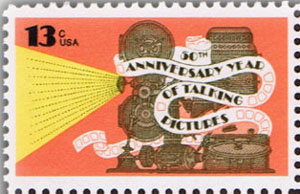
October 7 - 1879 Can Edison's phonograph speak
Arabic? New York Times.
October 8 - 1887 Edison Phonograph Company formed.
October 8 - 1895 The Berliner Gramophone Company
was incorporated with only $25,000 of paid capital. "This firm would control
manufacturing and sale of Gramophones and records while paying royalties
to Berliner's patent-holding organization, the United States Gramophone
Company." (Courtesy of The Talking Machine, Fabrizio & Paul)
October 10 - 1993 Charles Sumner Tainter, who
had collapsed from overwork in 1890 and resigned his position as head of
the Graphophone factory in Bridgeport, Connecticut, began developing a coin
mechanism for Graphophones. He perfected an antecedent of the design which
would serve nickel-in-the-slot Graphophones for the next ten years (patent
No. 506,348, October 10, 1893)" (Courtesy of The Talking Machine,
Fabrizio & Paul)
October 10 - 1902 Victor
shipped the first of a new type of disc talking machine. It was a "Monarch
Special" equipped with a cast rear support upon which the horn was mounted.
The soundbox was connected to the horn by a swinging tube of consistent
diameter. The steel needle was now subject only to the weight of the soundbox
and the inertia of the hollow arm. The weight of the horn had been removed
from the equation. Record wear was significantly diminished through the
use of the Victor tubular or "Rigid Arm."" (Courtesy of The Talking Machine,
Fabrizio & Paul)
October 10 - 1941 Birthday
of Pauline Hahn, a honorary Friend of the Phonograph for her
1959 phonograph movie scene in "Too Young to Love."

October 16 - 21
Edison Week - "Set apart for
special observance by Edison Dealers as an acknowledgement of one of Thomas
A. Edison's greatest contributions toward human progress, his favorite invention,
The New Edison." The Talking Machine World, October
15, 1916
October 21 - 1915 Edison
Day and First Pacific Edison Tone-Test given at the Panama-Pacific International
Exposition as part of Edison Day -- a day set aside for honoring the great
inventor. "General Electric had promoted the event celebrating the
thirty-sixth anniversary of the incandescent electric light" (2).
Edison listened to Anna Case's "Bird Song"
recording utilizing the transcontinental telephone, showing that music of
the Edison Diamond Disc Phonograph could be carried from ocean to ocean
and an Edison Tone Test was performed by Christine Miller.
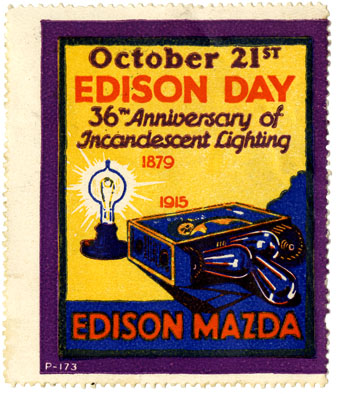
October 23 - 2001 Apple "unveiled the
first version of its handheld music player to the world on Oct. 23, 2001,
and it went on sale the following month. With the slogan "1,000 songs in
your pocket," the first-generation iPod was quick to capture the public's
attention and was the companion to the newly unveiled iTunes, the digital
music software that ushered in a new era of how people listen to music.
Apple went on to sell more than 400 million iPods, according to The
New York Times." (Courtesy NPR.org.)
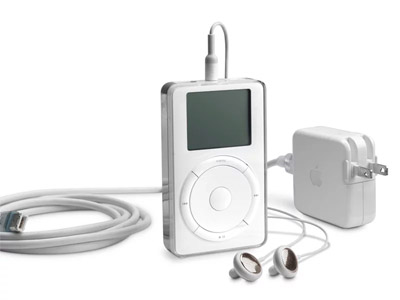
October 28 - 1887 The origin of the Edison doll
with contract transferring the toy manufacturing concern of Briggs and Jacques
to the Edison Phonograph Company. (Courtesy of The Edison Cylinder Phonographs
1877-1929, Frow & Sefl)
October 29 - 1887 "Edison's New Phonograph,"
Scientific American, from the New York Evening Post.
October 29 - 1929 The Radio-Phonograph Division
of Thomas A. Edison, Incorporated announced the end of record production
by Edison: "After a careful weighing of the record business and its prospects,
we have decided to discontinue the production of records, except for special
purposes, and to devote our great record plant to the production of radio,
and kindred new developments in the radio and home entertainment field.
The step is being taken regretfully because the phonograph for home entertainment
was one of Mr. Edison's favorite inventions. But, this is a case where sound
business judgment must prevail over sentiment. (Courtesy of The Talking
Machine, Fabrizio & Paul)
October 31 - Halloween
and the Phonograph
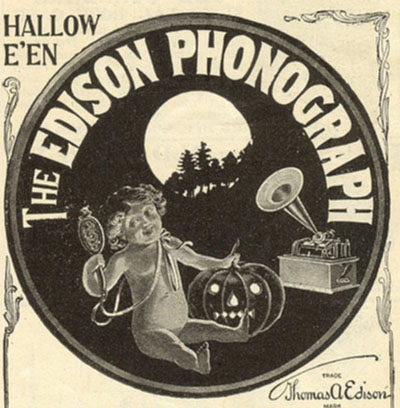
NOVEMBER
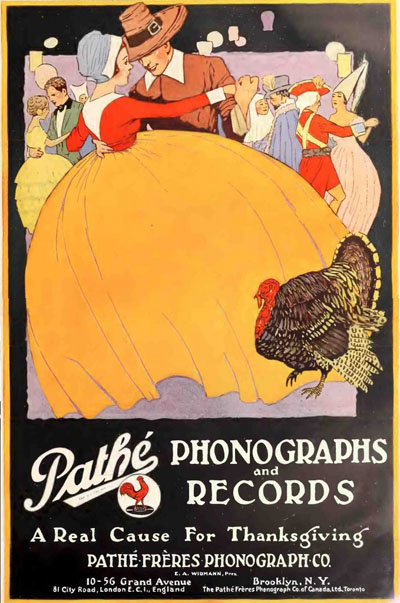
Click
HERE for Thanksgiving
November 1 - 1899 "Edison
cut the price of the "Concert" Phonograph to $100.00, matching that of the
Type "HG" Graphophone. Columbia had by this time acquired something of a
reputation by undercutting Edison retail prices." (Courtesy of The Talking
Machine, Fabrizio & Paul)
November 1 - 1904 C.
E. Hill patented (No. 773,740) the Phonograph Reproducer Attachment
for what was to become the Kalamazoo Duplex. The Duplex two-horn phonograph
was the brainchild of a Canadian immigrant named Charles E. Hill (born May
1862), a self-proclaimed “talking machine expert” from Lincoln, Nebraska.
Hill planned on manufacturing his Duplexophone in Lincoln. (Courtesy of
Wikipedia)

November 2 - 1925 "Victor Day", the day on which
the new "Orthophonic" Victrola (using the exponential horn) would be formally
unveiled. Victor had already released its first electrically-recorded disc
during May 1925 without fanfare, in order that stocks of acoustically-recorded
discs would continue to sell. (Courtesy of The Talking Machine, Fabrizio
& Paul)
November 7 - 1877 "The Phonograph," New York
Times. Read this anticipation of what the phonograph will bring (nearly
one month before its completion on December 6, 1877'.
November 11- 1902 "Edison had years before planned
to introduce cylinders made of durable celluloid. He was granted a patent
for such a process, No. 713,209, on November 11, 1902. Yet, rather than
immediately introduce the improved records, National Phonograph sued the
firm that was then producing celluloid cylinder records under the patent
of Thomas Lambert, to eliminate the competition. The unexpected result of
these efforts to brush the Lambert Company aside was that the court declared
the Edison patent void due to prior publication, a technicality. No other
celluloid patents would be available to Edison for some time. This meant
that when National Phonograph came to introduce the 200 tpi cylinder, it
was moulded of a harder but far more brittle version of the same metallic
soap material of the two-minute cylinders." (Courtesy of The Talking
Machine, Fabrizio & Paul)
November 17- 1877 "A Wonderful Invention.--Speech
Capable of Indefinite Repetition from Automatic Records," Scientific
American, November 17, 1877, p. 304.
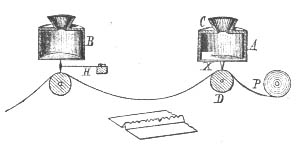
November 17- 1995 "Toy Story 2" release date.
Top-ten Friends of the Phonograph movie memory where Woody says "A
RECORD PLAYER! I haven't seen one of these in ages." Courtesy Walt Disney
Productions/Pixar
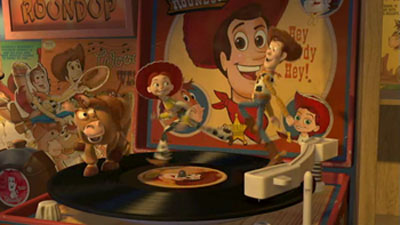
November 18- 1928 Release of "Steamboat Willie
starring Mickey Mouse in the historic black-and-white cartoon and the date
used for the birth of Mickey Mouse.. It was the first animated cartoon with
synchronized sound and was a sensational success. The Disney website describes
the cartoon as follows: "The cartoon marked an animation landmark with its
synchronized sound track where Mickey whistles and blows raspberries at
the irascible ship's captain, a large tobacco-chewing cat called Captain
Pete. In roughly seven minutes, Captain Pete kicks Mickey Mouse out of the
steering room of a riverboat. The hero then hoists Minnie Mouse on board
using a crane that grabs her by the knickers, swings a cat by the tail,
strangles a goose and plays keyboard on some suckling piglets as the American
folk song "Turkey in the Straw" plays from a goat's innards... After unsuccessfully
trying to make a deal to record through RCA or Western Electric, Walt contracted
with the bootleg Powers Cinephone process and, after a disastrous initial
recording session, finally recorded the soundtrack with a 15-piece band
and his own squeaks for Mickey. Directed by Walt Disney. Released at the
Colony Theater in New York on November 18, 1928, the date used for the birth
of Mickey Mouse." (Courtesy of Walt Disney Productions)
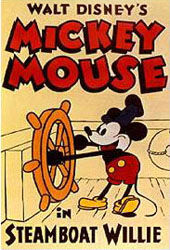
November 18- 1899 Judge magazine carried
a lampoon of William Jennings Bryan listening to a Phonograph. Bryan "always
likes to hear himself talk...likes his own "Rag-time" best and never
tires of hearing his stories over and over again."
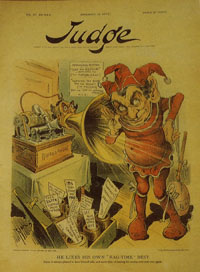
November 19- 1959 Rocket J. Squirrel and Bullwinkle
J. Moose make their first appearance in the ABC cartoon series Rocky and
His Friends. Hokey smoke! One memorable episode had a phonograph inside
a fake Moby Dick with a record of a fog horn that Boris played to try and
confuse Rocky and Bullwinkle.
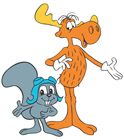
November 19- 1887 "Edison's Improved Phonograph,"
Scientific American, November 19, 1887, p. 328. From the New York World.
November 22 - 1901 First use of 'the dog' (Nipper)
on Victor Talking Machine Co. letterhead.
November 22 - 1911 Collins and Harlan sing "Everybody's
Doing It Now" (Irving Berlin song) on Victor 17020.
November 23 - 1889 The Birthday of the Jukebox
- On this day was the first public demonstration of a coin-operated phonograph.
Inventor and businessman Louis Glass rigged an Edison Phonograph with a
repeating mechanism and four selectively controlled sets of listening-tubes
and installed at the Palais Royal Saloon at 303 Sutter Street in San Francisco.
The machine did good business and some fifteen were subsequently fitted
out. (Courtesy of The Talking Machine, p. 24, Fabrizio & Paul)
November 23 - 1878 With Edison's support, Uriah
Painter and Edward Johnson take control of Edison Speaking Phonograph Co.
November 23 - 1936 Take 1 of "Phonograph
Blues" by Robert Johnson recorded in San Antonio, Texas.

November
24 - 1888 The Nebraska
State Journal on November 24, 1888, reported the introduction into
Lincoln of a new business machine, the phonograph. (Courtesy of History
Nebraska)
November 25 - 1905 Dexter W. Allis, "Fun With
the Phonograph," Scientific American.
November 26 - 1922 - British archaeologist Howard
Carter and his workmen entered the tomb of King Tutankhamen in the Valley
of the Kings in Egypt and "Tutmania" begins including the wonderful
Egyptian inspired decoration of the Reflecta-Gem
gramophone and the release in June 1923 of Edison Disc 51155-L Old
King Tut by Billy Jones and Ernest Hare. Listen
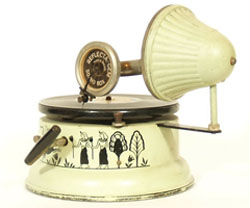
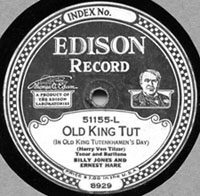
November 28 - 1893 Henri Lioret invented a celluloid
cylinder and patent received (Supplement to Patent 230177 of 18 May, 1893)
November 29 - 1877 Edison drew a sketch of the
phonograph which he gave to John Kruesi to build.
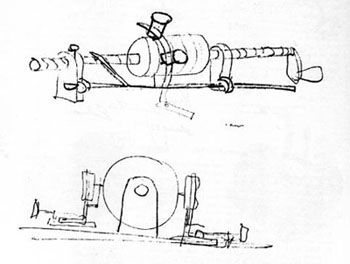
November
30 - (b. 1848 in Dublin, Ireland - d. March 11, 1924) - Chichester's
actual birthday is unknown *.
Chichester was cousin to Alexander Graham Bell and is
remembered for his work with Alexander Bell and Charles Tainter in the successful
development of the Graphophone.
Chichester made many important contributions to improving
the phonograph that are considered by Friends of the Phonograph worthy
of him having a red letter day for Phonographians to celebrate. November
30 was selected as the stand-in birthday because it was on November 30,
1892 that Bell helped to establish the Edison Bell company in London to
sell phonographs produced by the Edison United Phonograph Compnay.
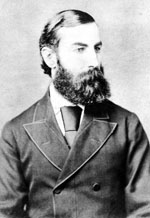
DECEMBER
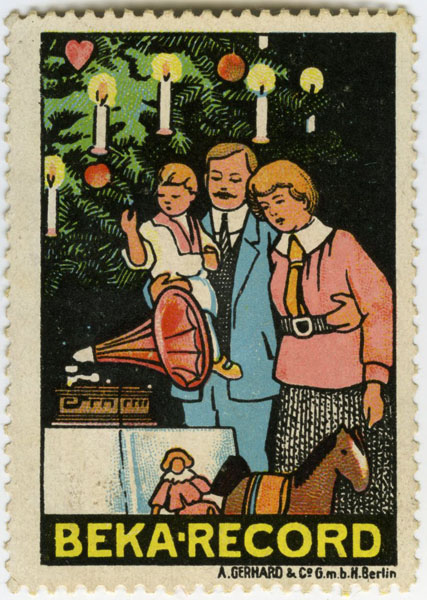
.
December 3
- 1877 envelope sealed on April 3, 1877 by Charles Cros and given to the
French Academy was opened and the Cros letter was read in public. This letter
establishes that Cros was the
first person to conceive a method for reproducing recorded sound with an
invention he named the Paleophone.
December 3
- 1888 "Kisses By Phonograph. The Limitless Possibilities of That Recording
Instrument." New York Times
December 4 - 1877 John Kruesi presents Edison
the Phonograph for testing. "Kreusi made the phonograph today" entered in
Charles Batchelor's Day Book. (Courtesy of The Edison Cylinder Phonographs
1877-1929, Frow & Sefl)
December
6 - 1877 Birthday of the Phonograph as Edison speaks "Mary
had a Little Lamb" in a successful demonstration of the Phonograph. "Kruesi
finished the phonograph today," (Charles Batchelor's Day Book) (Courtesy
of The Edison Cylinder Phonographs 1877-1929, Frow & Sefl)
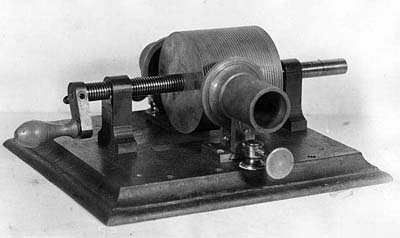
December
6 - The Phonograph's Birthday Anniversary Parties celebrated
by Friends of the Phonograph
December 6 - 1966 Recording of Sgt. Pepper's
Lonely Hearts Club Band began at Abbey Road Studios by The Beatles. Known
for its creative album cover it has been called one of the most influential
rock albums of all-time.
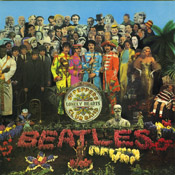
December 6 - 1896 - Birthday of Ira Gershwin,
American lyricist of Broadway musicals and films.
December 6 - 1923 - A presidential address was
broadcast on radio for the first time as President Calvin Coolidge spoke
to a joint session of Congress.
December 6 - 1963 - Beatles begin a tradition
of releasing a Christmas record for fans.
December 6 - 1964 - "Rudolph The Red-Nosed Reindeer"
1st airs on TV.
Gene Autry's recording of "Rudolph" hit No.
1 on the U.S. charts the week of Christmas 1949. Including covered versions,
sales of Rudolph recordings exceed 150 million copies, second only to Bing
Crosby's "White Christmas".
December
6 - Santa, Christmas
and the Phonograph - Celebrating the Birthday of the Phonograph and also
the day in cultures where Saint Nicholas, Sinterklass, et al. visit and
bring gifts (in the evening of December 5, or on December 6).
Santa and Christmas become major advertising themes
for the phonograph industry.
December 7 - 1877 The day after the Phonograph
was completed, Edison took his tin-foil playing machine to the offices of
Scientific American for a triumphant demonstration where the Phonograph
"introduced itself." An account of this meeting and a description of the
talking machine was published in the December 22, 1877 issue of Scientific
American.
December 7 - 1877 Edison Notebook entry
1144: Charles Batchelor
letter to the Editor of the English Mechanic. Batchelor describes Edison's
new Phonograph and how Edison has devised a method of recording and reproducing
the human voice. (Courtesy of The Papers of Thomas A. Edison, Volume
3, John Hopkins University Press)
December 7 - 1877 Edison Notebook entry
1145: Edward Johnson letter to Uriah Painter. Received delivery of Phonograph.
(Courtesy of The Papers of Thomas A. Edison, Volume 3, John Hopkins
University Press)
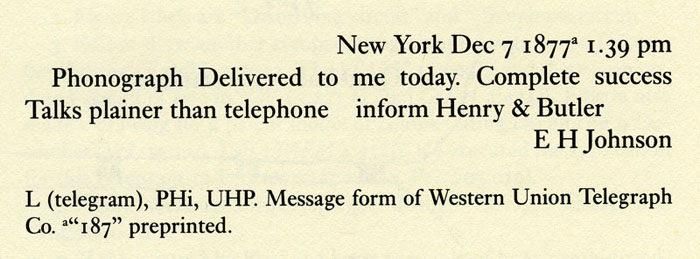
December 8 - 1888 The Real
Music of the Future, published by Punch magazine, December 8,
1888.
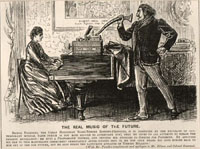
December 9 - 1914 Edison Factory fire, West Orange
NJ. Destruction included the Phonograph Works and the great record plant,
known as 24 building.
December 10 - 1901 "On December 10, 1901. after
more than four years of effort, the Jones patent for recording in wax (No.
688,739) was issued. Columbia quickly purchased it from J.W. Jones for $25,000.
This patent, in addition to the famous Bell-Tainter patents, gave Columbia
a formidable legal position in the disc market." (Courtesy of The Edison
Cylinder Phonographs 1877-1929, Frow & Sefl)
December 15 - 1877 Edison files application for
phongraph patent. (Courtesy of Edison Cylinder Records, 1889-1912, Koenigsberg,
Allen, APM Press, ©1987, p. viii).
December 20 - 1893 Henri Lioret developed "a
celluloid cylinder along with a Lilliputian mechanism to play it. He filed
for an American patent on December 20, 1893. It was granted ten months later,
and Lioret applied himself to constructing the small machines and cylinders
for installation in the talking dolls of the Jumeau firm. The Bebe Jumeau
dolls sold well for 38 francs. The talking mechanism was available separately
as "Le Merveilleux" for 20 francs....The dainty "Le Merveilleux" retains
the distinction of being the first European-made talking machine to play
removable cylinders, and the very first anywhere to use celluloid cylinder
records."(Courtesy of The Talking Machine, Fabrizio & Paul)
December 22
- 1877 Scientific American article published based on the December
7th Phonograph demonstration given by Edison in Scientific American's office
in New York City. An account of this meeting, including the day-old invention
introducing itself to everyone in the room, make this a memorable publication
event for Friends of the Phonograph.
.
December
25 - Christmas and the Phonograph. Originating in Western Christian
popular culture Santa Claus delivers Christmas Eve gifts normally opened
the following morning, December 25. When the phonograph became a home entertainment
device Santa and Christmas became major advertising themes for the phonograph
industry.
December
26 - 1863 Birthday of Charles Morand Pathé (French), a pioneer
of the French film and recording industries. In 1896, with his brothers
Émile, Théophile and Jacques, Charles Pathé founded Société Pathé Frères
(Pathé Brothers) in Paris, a company that manufactured and sold phonographs
and phonograph cylinders, with Émile at his head.

December 26 - 1877 Edison Notebook entry 1159:
Transmitted Phonograph recording over the telephone. (Courtesy of The
Papers of Thomas A. Edison, Volume 3, John Hopkins University Press)
.
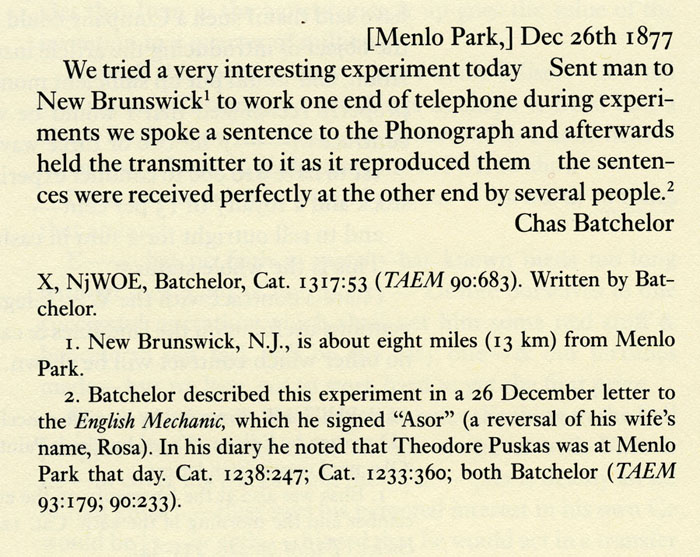
December 28 - 1877 Edison Notebook
entry 1160: Edison proposed embossing "wheels" to be used in talking dolls
and talking clocks, advertisements, delivering lectures and producing music.
(Courtesy of The Papers of Thomas A. Edison, Volume 3, John Hopkins
University Press)
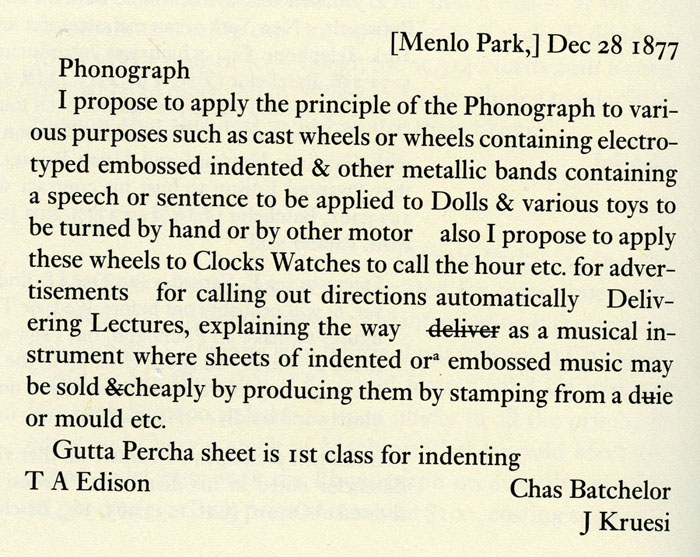
.
December
28 - 1895 - The first demonstration to a paying audience of the
Auguste and Louis Lumières' Cinématographe in the Salon Indien,
a basement room of the Grand Café at 14 Boulevard des Capucines,
near the place de l'Opera in Paris. Traditionally marked as the birth of
the cinema. The Cinématographe was a device that
could project moving pictures rather than being limited to one viewer at
a time as was the case with Edison's coin-in-the-slot Kinetoscope.
.
December
29 - 1888 Punch, or the London Chavari, in which Mr. Punch describes
his Funnigraph to Father Time as something Mr. Punch invented long
before the days of Edison. Mr. Punch's original, ingenious, unsurpassable
Patent Funnigraph is his Ninety-Fifth Volume of Punch.
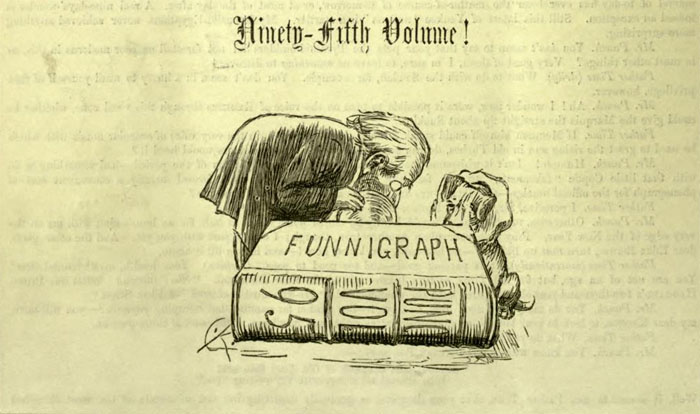
December 31- 1907 Patent No. 874,985
was issued to Arthur J O'Neill. "In the text he gave a concised description
of the nature of the talking machine business in Chicago: "In the sale of
talking machine records, it is desirable that the record be shaped with
special reference to the machine for which it is primarily intended in order
that the manufacturer...may control the sale of records to be used therewith.""
(Courtesy of The Talking Machine, Fabrizio & Paul)
.
WHAT DAY IS IT?
GEORGE: Gracie, what
day is it today?
GRACIE: Well, I don't know.
GEORGE: You can find out if
you look at that paper on your desk.
GRACIE: Oh, George, that doesn't
help. It's yesterday's paper. (1)
 |
|

Burns & Allen 78rpm, Columbia
1932
|
GRACIE: George, why do they print
'Monday, July 6th, 1936' on this paper?
GEORGE: Well, because today is Monday,
July 6th, 1936.
GRACIE: Well,
wouldn’t you think they could find something a little newsier than that
for the front page?”
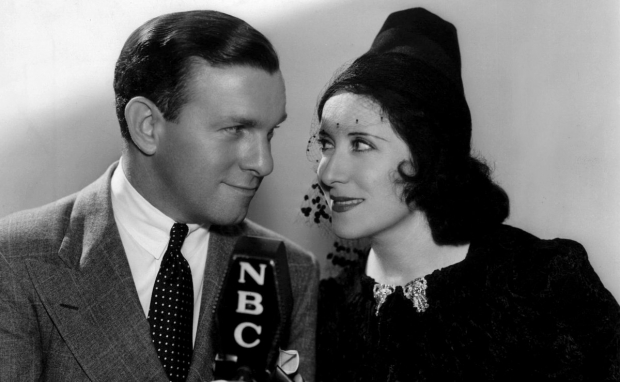
1936
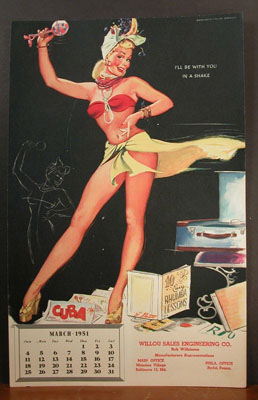
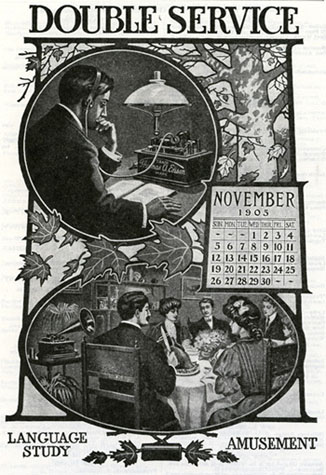
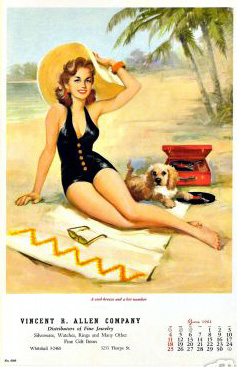
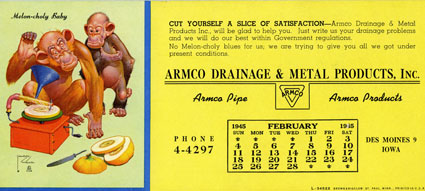
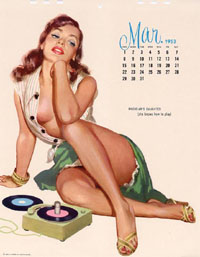
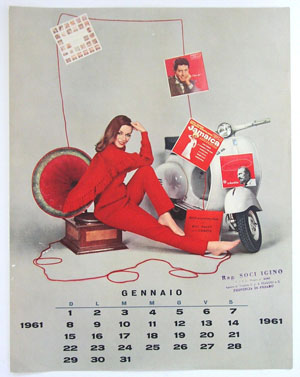
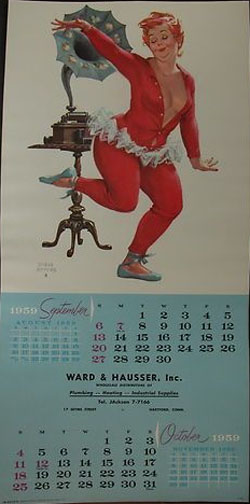
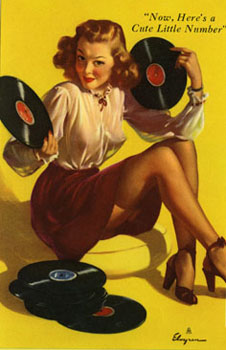

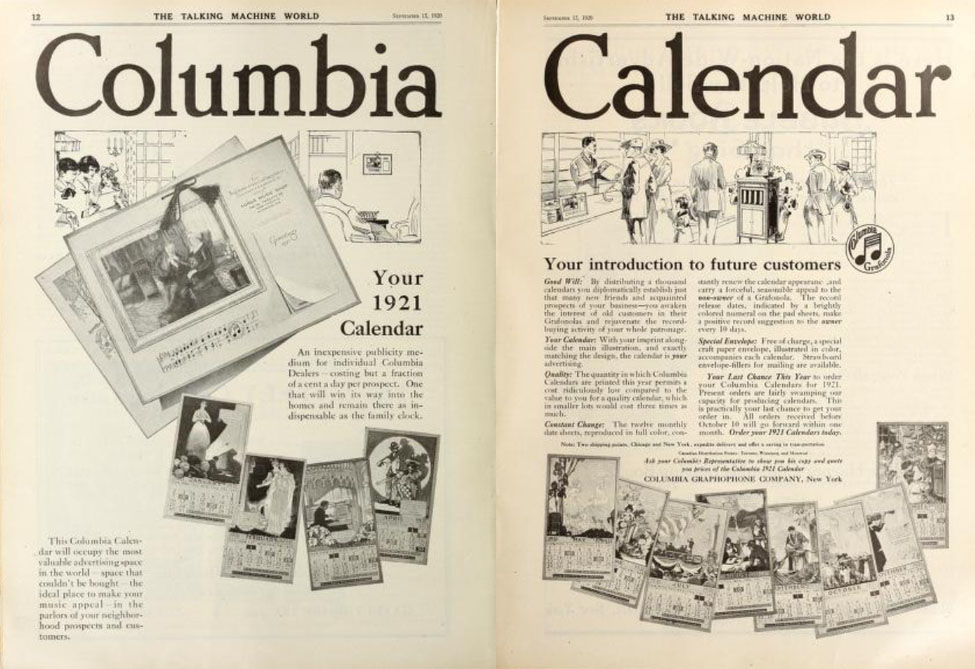
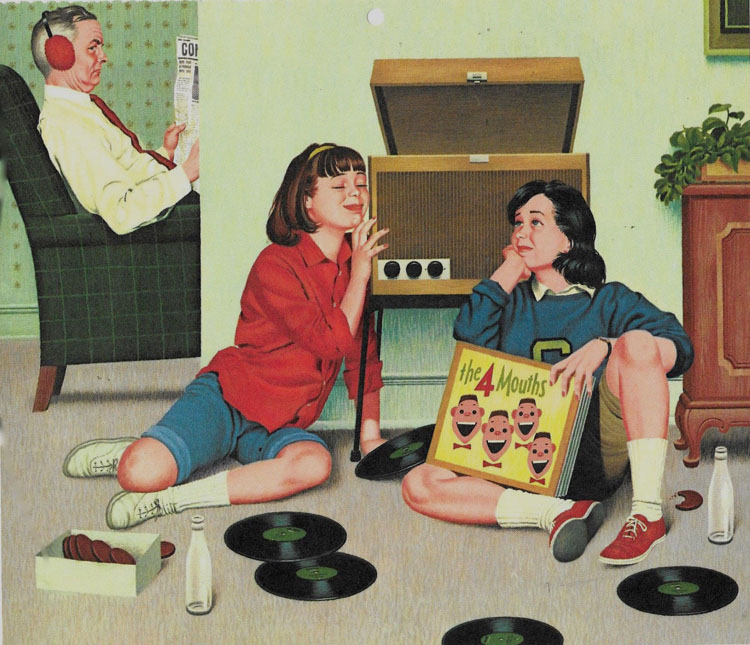

1943 RCA Calendar
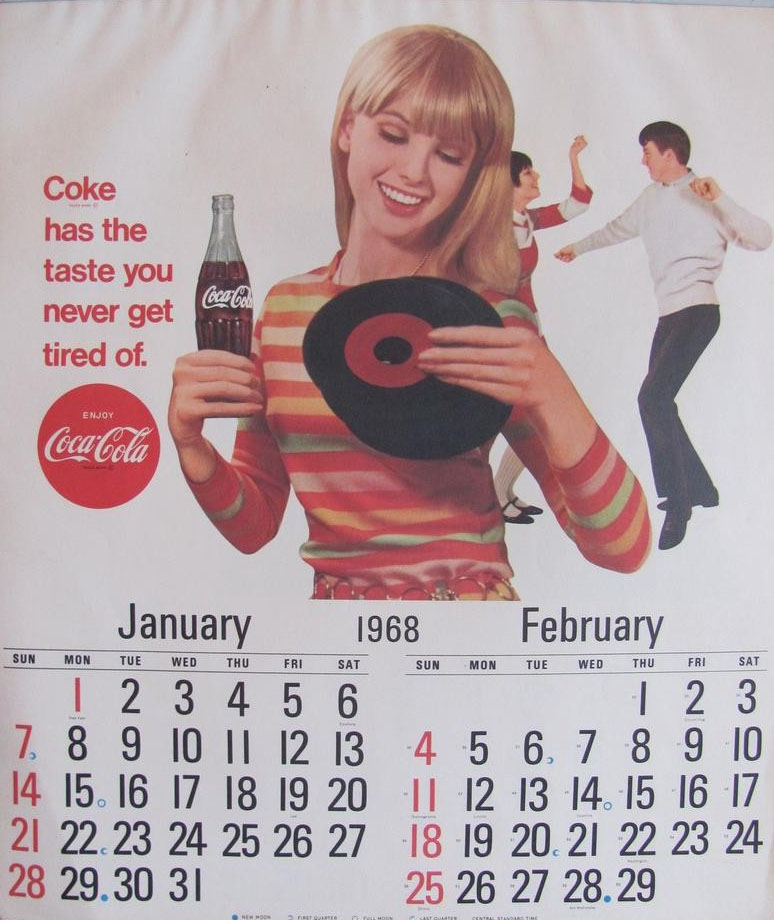
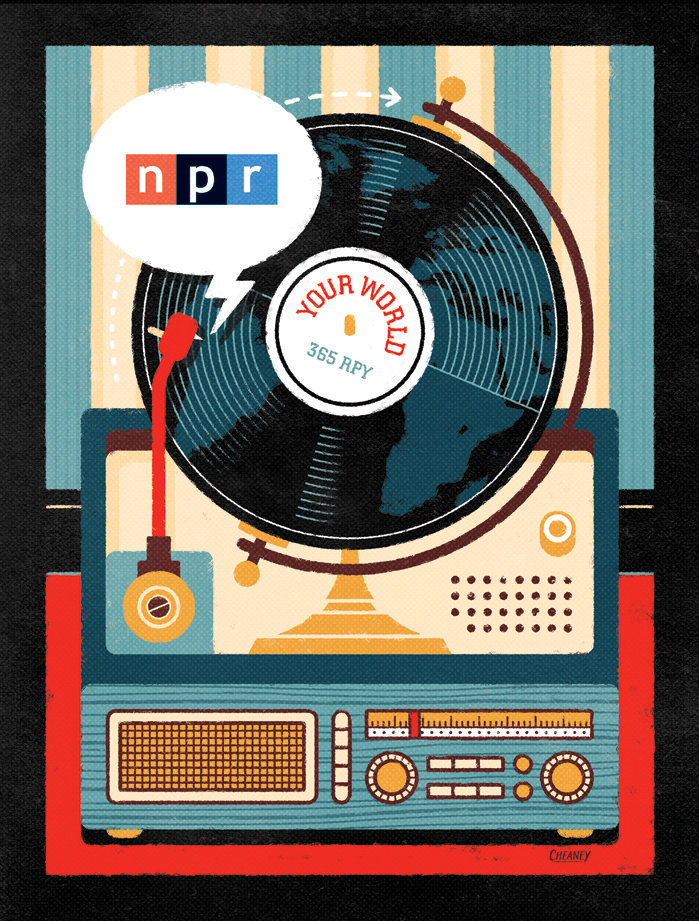
NRP 2013 Wall Calendar by Philip Cheaney/NPR
I love what Cheaney says about his calendar:
"NPR distills Earth's spin down to a
reliable stream of enlightened audio, 365 rotations per year. I liken this
to the idea of a globe spinning like a record, with NPR as the record needle
transforming the world's happenings into audio content." Philip Cheaney
@PhilipCheaney Listens to WNYC, New York, NY
.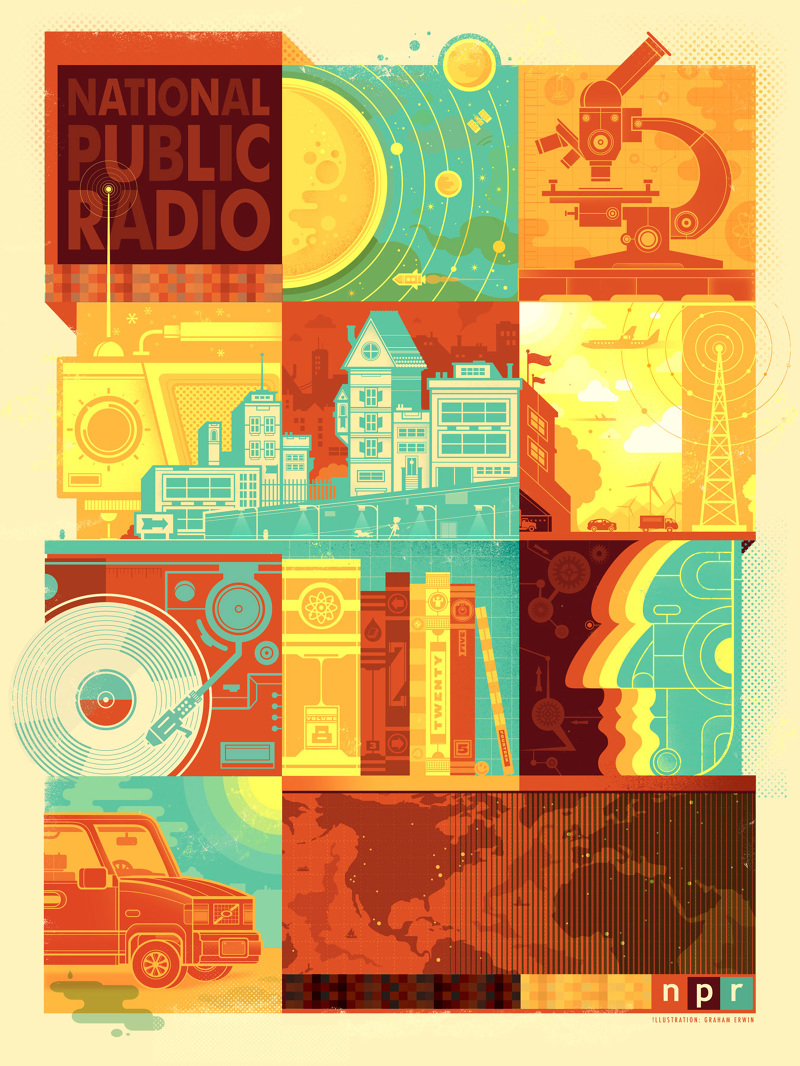
NRP 2014 Wall Calendar by Graham Erwin/NPR
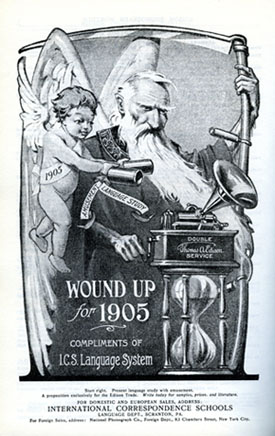
See the other 1905 Edison Double
Service Calendar Advertisements
Calendar's
Image Index

Phonographia
